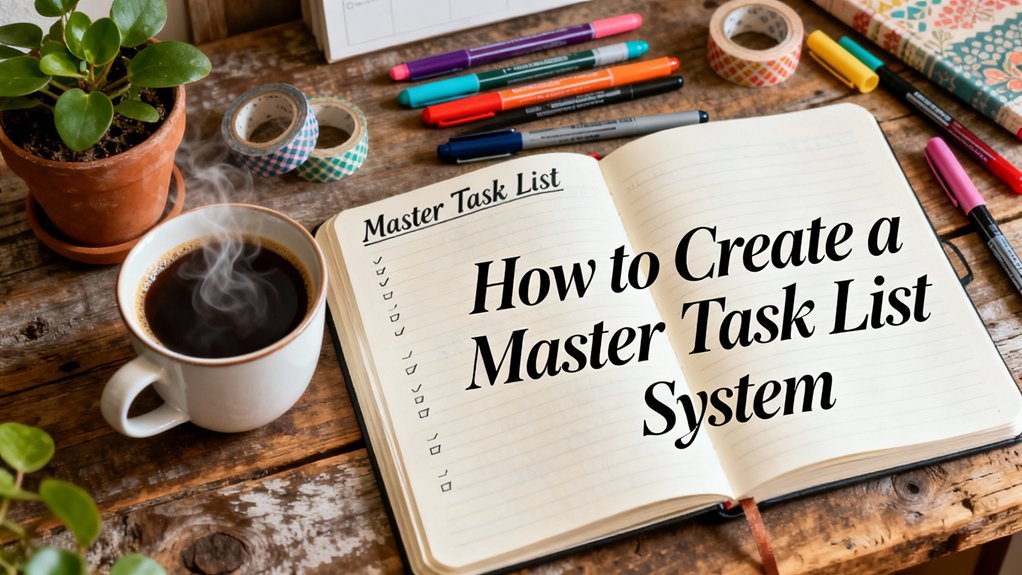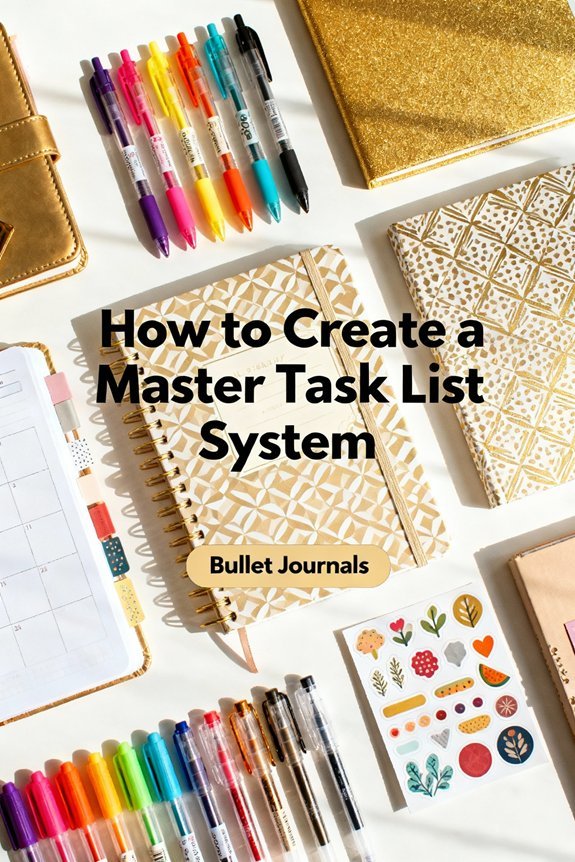Start by selecting one central capture tool—either digital like Todoist or analog like a notebook—where you'll record every task. Divide your list into 5-7 clear categories matching your life roles (work, personal, health). Schedule a daily 5-minute scan and weekly 20-30 minute review to process entries. Add priority markers (Critical/High/Medium/Low) and time indicators (15min/30min/1hr/2hr+) to each task. Each morning, extract specific items into your daily plan with scheduled time blocks. The systematic approach below converts this framework into an execution system.
Key Takeaways
- Choose a central capture tool—digital or analog—that minimizes friction and test three options for a week.
- Establish 5-7 clearly labeled categories reflecting your life roles to organize tasks and maintain focus.
- Schedule daily 5-minute and weekly 20-30 minute review sessions to process, prioritize, and update your list.
- Apply priority markers, time indicators, energy levels, and deadlines to tasks for efficient decision-making.
- Extract daily tasks each morning, time-block them as commitments, and update both lists upon completion.
Choose Your Central Capture Tool

Your task list system lives or dies by your central capture tool—the single place where every task, idea, and commitment lands before it slips away.
Select between digital tools and analog methods based on your user preferences and workflow requirements. Digital software options like Todoist, Things, or Notion offer strong integration capabilities with calendars, email, and mobile applications. These platforms provide accessibility features across devices, ensuring you'll capture tasks wherever inspiration strikes.
Analog methods—notebooks or index cards—eliminate digital distractions and offer tactile satisfaction some innovators prefer. The Bullet Journal Method uses writing and reflection to help clear mental clutter and reconnect with what truly matters in your task management. The key isn't choosing the most sophisticated option; it's selecting what you'll actually use consistently.
Evaluate task organization structures each tool provides. Can it handle projects, tags, and priorities? Does it sync smoothly across your devices?
Test three options for one week each. Your ideal capture tool should feel frictionless—adding tasks takes seconds, not minutes. Once chosen, commit completely. Multiple capture points create chaos, not clarity.
Establish Categories That Match Your Life Structure
Once you've established your capture tool, divide your tasks into categories that mirror how you actually spend your time. Create buckets based on your life roles—professional, personal, health, relationships, learning—rather than arbitrary labels. This task grouping method guarantees you're allocating attention across all dimensions of your life.
Start with 5-7 core categories maximum. Too many fragments your focus; too few creates chaos. Label each category clearly: “Work Projects,” “Home Management,” “Fitness Goals,” “Skill Development.” These aren't just folders—they're commitment zones that reflect your priorities.
Categories aren't organizational tools—they're commitment zones that transform scattered tasks into intentional priorities deserving your focused attention.
Test your categories for two weeks. If you're consistently unsure where tasks belong, refine your structure. Effective categories should feel intuitive, not complicated. Your system should accelerate decision-making, not slow it down.
Remember: your categories will evolve as your life shifts. Review quarterly and adjust. The goal isn't perfection—it's creating a framework that serves your current reality and future ambitions.
Develop a Regular Review and Processing Routine

Schedule dedicated time blocks—daily and weekly—to process your task list and maintain its integrity. Your review frequency determines whether your system becomes a trusted productivity engine or organizational dead weight.
Implement a daily five-minute scan each morning to identify priorities and adjust for changing circumstances. Execute a thorough weekly review lasting 20-30 minutes to clear completed items, reassess deadlines, and migrate stalled tasks.
Your processing techniques should follow a consistent protocol: capture new inputs immediately, clarify vague items into actionable steps, categorize by context, and eliminate outdated commitments.
Install trigger reminders that prompt these reviews automatically—linking them to existing habits amplifies compliance.
Transform review sessions from administrative chores into strategic planning moments. You'll spot patterns, identify bottlenecks, and recalibrate your workload before minor issues compound.
This disciplined rhythm converts your task list from static inventory into fluid workflow management, ensuring nothing critical slips through while maintaining forward momentum on meaningful objectives.
Set Up Priority Markers and Time Indicators
Priority markers change undifferentiated task sprawl into a navigable action hierarchy that directs your attention where it matters most.
You'll convert chaotic lists into actionable sequences through strategic coding systems.
Implement these priority ranking mechanisms:
- Deploy a four-tier urgency scale (Critical/High/Medium/Low) that distinguishes between fire-drills and background noise. Assign markers based on deadline proximity and impact magnitude.
- Add time-block indicators showing estimated completion duration (15min/30min/1hr/2hr+). This enables efficient time management by matching tasks to available windows throughout your day.
- Flag deadline-sensitive items with specific dates rather than vague labels. Concrete timestamps create accountability and prevent drift.
- Mark energy-level requirements (High/Medium/Low focus needed) to align demanding work with your peak performance periods.
These systematic markers eliminate decision fatigue.
You'll instantly identify what deserves immediate action versus what can wait, optimizing your execution velocity without constant re-evaluation.
Integrate Your Master List With Daily Planning

Your prioritized master list becomes operational only when you extract specific tasks into focused daily plans. Each morning, review your master list and select 3-5 high-impact items that align with your current objectives. This practice guarantees task alignment between long-term priorities and immediate action.
Create a dedicated daily planning ritual. Allocate five minutes to transfer selected tasks from your master list into today's schedule. Block specific time slots for each item, treating these appointments with yourself as non-negotiable commitments.
Your daily goals should reflect both urgent deadlines and strategic priorities from your master list. Cross-reference your priority markers to identify which tasks deliver maximum value today. As you complete items, update both your daily plan and master list simultaneously.
This integration changes your master list from a static inventory into a lively execution system. You'll maintain momentum on long-term projects while handling immediate demands, creating a smooth workflow between planning and doing. For additional support in refining your task management approach, consider working with a certified GTD coach who can provide personalized guidance on implementing these systems effectively.
Frequently Asked Questions
How Do I Handle Tasks That Involve Other People's Input or Decisions?
Create a dedicated “waiting on” category in your task system and flag each item with the person's name and required action.
You'll need strong communication techniques—set clear deadlines and follow-up reminders.
Implement collaboration strategies like shared project boards where stakeholders can track progress transparently.
Don't let tasks stagnate; schedule automatic check-ins and escalation protocols.
This systematic approach converts dependencies into manageable workflows, ensuring you're driving innovation forward rather than waiting passively.
What Should I Do With Tasks That No Longer Feel Relevant or Important?
Like pruning dead branches from a tree, you'll need to cut away irrelevant tasks to let essential work flourish.
Implement task elimination strategies by conducting weekly reviews—ask yourself: “Does this align with current goals?” If not, delete it immediately.
Apply prioritization techniques like the Eisenhower Matrix to distinguish urgent from obsolete items.
Don't let outdated commitments drain your energy. Archive completed work, eliminate the rest, and redirect your focus toward high-impact innovation that drives real results.
How Can I Prevent My Master Task List From Becoming Overwhelming?
You'll prevent overwhelm by implementing task prioritization techniques that rank items by impact and urgency.
Break down large projects using manageable task segmentation—divide ambitious goals into bite-sized actions you can tackle daily.
Review your list weekly, archiving completed tasks and deferring low-priority items to a “someday” folder.
Limit your active list to 15-20 current tasks maximum.
This systematic approach changes your master list from a crushing burden into a vibrant tool that drives meaningful progress forward.
Should I Share My Master Task List With Family or Colleagues?
Share strategically based on sharing benefits and privacy concerns.
You'll want to create separate views: keep personal items private while exposing collaborative projects to colleagues and family commitments to household members.
This approach enhances accountability without compromising sensitive information.
Use role-based access controls in your system to automate this division.
You'll boost coordination, reduce duplicate efforts, and maintain healthy boundaries.
Start by categorizing tasks by audience today—it's revolutionary for productivity.
How Do I Balance Long-Term Goals With Urgent Daily Tasks?
Picture your week as a canvas where bold strokes represent your significant goals while fine details capture urgent demands.
You'll master this balance through goal prioritization techniques like time-blocking: dedicate morning hours to long-term projects before daily fires ignite.
Implement daily task management by categorizing items using the Eisenhower Matrix—separating urgent from important.
Schedule non-negotiable weekly progress sessions for strategic goals, ensuring they're not perpetually overshadowed by immediate pressures.
You'll achieve sustainable momentum this way.
Conclusion
You've built the framework—now put it into motion. Your master task list isn't a trophy to admire; it's a living engine that drives your productivity forward. Execute your daily reviews, act on your priorities, and watch scattered obligations change into completed milestones. This system only works when you work it consistently. Stop planning to plan and start doing. You'll capture everything, accomplish what matters, and finally gain control over your chaos.











